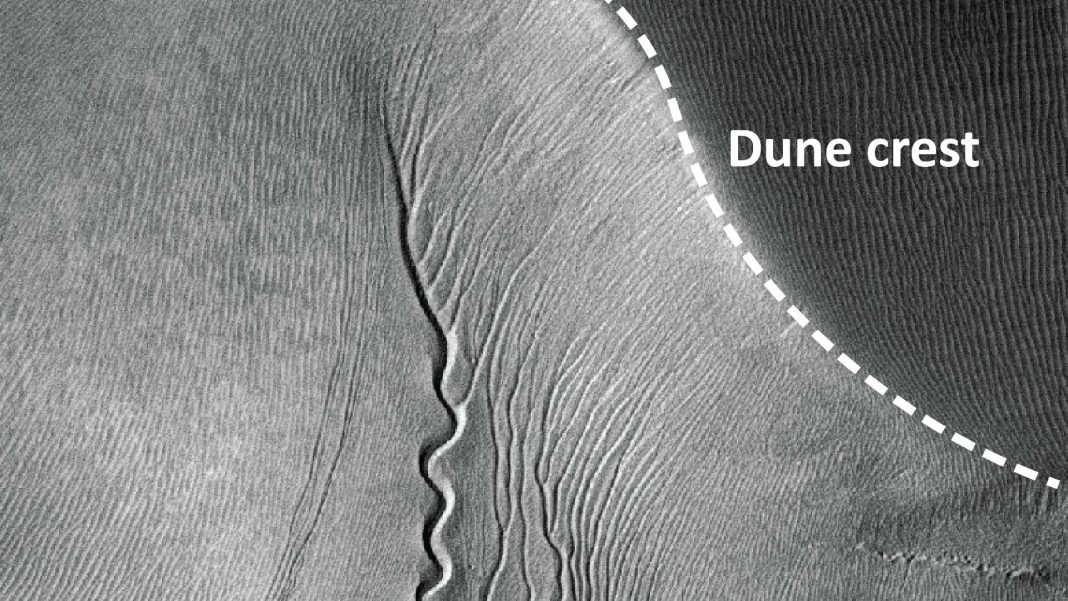Imagine the desolate red plains of Mars, vast and silent, echoing with the whispers of ancient winds. Now, picture something moving across that landscape, leaving trails and carving pathways, a force of nature akin to the colossal sandworms of Arrakis in Frank Herbert’s Dune. Except, instead of gargantuan biological creatures, what if the true architects of some Martian movements were far more mundane, yet equally astonishing: dry ice?
Recent insights from space research have cast a surprising new light on how certain features on the Red Planet’s surface might be formed. It turns out that Mars’s abundant frozen carbon dioxide, or dry ice, isn’t just sitting still. It’s actively shaping the landscape in a process so peculiar, it sounds like science fiction.
The Martian Ballet of Moving Boulders
For years, scientists have observed perplexing patterns on Mars: strange, elongated trenches, grooves, and even evidence of boulders that appear to have moved from their original positions. These enigmatic markings suggested some unknown, powerful force at play, almost like the subterranean tremors caused by Dune‘s mighty sandworms. What could be creating these migratory traces on such a seemingly static world?
The answer, according to researchers from institutions like the Arizona State University, lies not in exotic life forms, but in the unique properties of dry ice under Martian conditions. On Earth, dry ice sublimes – turns directly from solid to gas – but the process is usually gentle. On Mars, with its incredibly thin atmosphere and extreme temperatures, this process takes on a dramatic flair, turning seemingly inert ice blocks into dynamic geological tools.
How Dry Ice Becomes a Sandworm (Kind Of)
Mars’s polar caps contain vast quantities of frozen carbon dioxide. When the Martian sun begins to warm these areas, especially in spring, the dry ice at the bottom of these slabs doesn’t melt into a liquid; it sublimates directly into gas. Crucially, this gas gets trapped beneath the overlying ice. Think of it like a natural hovercraft.
As the pressure from the trapped CO2 gas builds, it creates a cushion, lifting the entire slab of dry ice, along with any rocks or dust resting on top of it. This gas then acts as a lubricant, allowing these massive ice blocks to slide downslope with astonishing ease, carving out those long, distinctive grooves that have puzzled scientists for so long. It’s a seasonal phenomenon, turning passive ice into an active geological agent.
“It’s a testament to the diverse and often counter-intuitive processes at play on other worlds,” mused a planetary scientist discussing the findings. “Just when you think you understand a planet, it reveals another layer of complexity, often through the most unexpected materials.” This elegant, albeit bizarre, mechanism explains not only the grooves but also the curious movement of boulders that occasionally ride along on these sublimating ice rafts.
A New Perspective on a Familiar Planet
This “dry ice sandworm” theory offers a thrilling new perspective on how Mars’s surface is constantly being shaped. It highlights the dynamic nature of what we often perceive as a barren, static planet. Understanding these processes is crucial for future Martian exploration, helping us interpret surface features, identify potential hazards, and even pinpoint areas where subsurface ice might be more accessible.
So, the next time you gaze up at the Red Planet, remember that its surface isn’t just a canvas of ancient impacts and dust storms. It’s also a stage for the surprising, slow-motion ballet of dry ice, carving its own fantastical paths, much like the legendary sandworms of Arrakis – proving that sometimes, the most dramatic geological forces come from the most unexpected, everyday elements.




